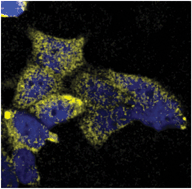Despite the potential benefits of selective redox-modulating strategies for cancer therapy, an efficacious methodology for testing therapies remains elusive because of the difficulty in measuring intracellular redox potentials over time. In this report, we have incorporated a new FRET-based biosensor to follow in real time redox-sensitive processes in cells transformed to be tumorigenic and cultured in a microfluidic channel. A microfluidic network was used to control micro-scale flow near the cells and at the same time deliver drugs exogenously. Subsequently, the response of a redox homeostasis circuit was tested, namely reduced glutathione (GSH)/oxidized glutathione(GSSG), to diamide, a thiol oxidant, and two drugs used for cancer therapies: BSO (L-buthionine-[SR]-sulfoximine) and BCNU (carmustine). The main outcome from these experiments is a comparison of the temporal depletion and recovery of GSH in single living cells in real-time. These data demonstrate that mammalian cells are capable of restoring a reduced intracellular redox environment in minutes after an acute oxidative insult is removed. This recovery is significantly delayed by (i) the inhibition of GSH biosynthesis by BSO; (ii) the inactivation of glutathione reductase by BCNU; and (iii) in tumorigenic cells relative to an isogenic non-tumorigenic control cell line.

You have access to this article
 Please wait while we load your content...
Something went wrong. Try again?
Please wait while we load your content...
Something went wrong. Try again?


 Please wait while we load your content...
Please wait while we load your content...